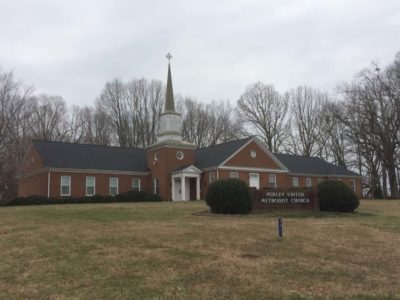From the publisher: The separation of white and black schools remained largely unquestioned and unchallenged in North Carolina for the first half of the twentieth century, yet by the end of the 1970s, the Tar Heel State operated the most thoroughly desegregated school system in the nation. In Race and Education in North Carolina, John Batchelor offers a robust analysis of this sea change and the initiatives that comprised the gradual, and often reluctant, desegregation of the state’s public schools.
The Greensboro city system, located within Guilford County, provides a particularly positive illustration of the (desegregation) process. Greensboro was among the last of the state’s largest cities to implement busing, but its plan featured unusually solid preparation.
In 1970, Dr. George Simkins, local NAACP branch president, and a group of black parents had filed suit. The Board of Education reached a settlement by the end of the year.
For Al Lineberry, who chaired the board, the decision to end segregation had been made long ago: “I was sitting in a little restaurant downtown, eating breakfast. It was rainy, icy. I remember to this day what I was eating — country ham, grits, and eggs. And I saw, behind the door, this black lady. I was brought up in Memphis, Tennessee, and I was taught the racial code just like any other white growing up in the South. She had two children with her. I could tell they were hungry.
“She looked in, but she waited. And waited. She wasn’t asking for a handout, she had the money to pay. But then she had to go back out in the cold and give the food to her children to eat, outside, in the cold rain. Quietly, I began to cry.”
Early on, members of the business community, working through the Chamber of Commerce, created discussion groups so that blacks and whites could meet quietly and get acquainted. Lineberry and other business leaders concluded, “It was clear that we would be lagging with regard to economic development — in this part of the country if we didn’t do a better job of educating more of our children.” Early on, the board initiated conversations with local ministers. Lineberry credits Rev. Otis Hairston, a black minister, for the positive influence he exerted on leaders of the white community.
Doing the right thing
During the spring and summer of 1971, black and white community leaders attended retreats where they got to know each other and practiced techniques for cooperation. Three black administrators, Fred Cundiff, Julius Fulmore, and Mel Swann, prominent in the black community, played key roles. Meetings at schools enabled parents to visit with teachers and administrators and with each other. Mayor E.S. “Jim” Melvin proclaimed August 15 as “Public School Sunday,” and on that day almost every minister in the city preached a sermon on the theme of racial harmony. They spoke to their congregations about nurturing children and thinking about the changes that were underway.
Sermons emphasized that the change was not about color; it was about doing the right thing by giving all children equal opportunities for education.
The following Sunday, every school bus in the city carried approximately thirty thousand parents to the schools their children would be attending, where parents met their children’s new teachers. …
During the early days of busing, Lineberry, his wife, and his children were threatened. He and his family had around-the-clock police protection. But gradually, students in a fully desegregated school system learned to experience normal school days. Regarding the progress of school desegregation, Dr. Simkins subsequently commented, “I feel so proud to say I’m from Greensboro.”
Other communities experienced similar successes, along with varying degrees of difficulty. But they all desegregated their schools. North Carolina’s political leaders competed to improve education during the mid- to late-1970s. In the election of 1972, the people chose Republican James Holshouser over Democrat Hargrove “Skipper” Bowles, who had held a position in the Sanford administration. … Holshouser emphasized ways to improve traditional structures: expansion of kindergarten, class size reduction, and improved buildings, in addition to renovations to roads and bridges, as well as improving financial efficiency. Time magazine termed Holshouser “notably liberal on racial matters.” In 1973, he gave the Founder’s Day address for African Methodist Episcopal (AME) churches, one of the largest black denominations in the nation.
The Holshouser administration secured passage of a $300 million bond issue to supplement local efforts in school construction, added a tenth month to teacher employment, provided paid vacation for teachers, made principals year-round employees, and initiated state-funded kindergarten. Class sizes were reduced, and improved retirement benefits were funded for educators and other state employees. An initiative begun in 1975, the Primary Reading Program, added an assistant in each classroom, grades one through three, and provided materials and professional development for reading teachers and assistants. These initiatives were accomplished in spite of a serious recession and an energy crisis that plagued the economy.
Enter Jesse Helms
The 1972 election also brought in a Republican U.S. senator from North Carolina. One of the strongest voices in opposition to forced desegregation had emerged from Jesse Helms, the radio commentator whose political career had been forged during the Willis Smith-Frank Porter Graham campaign. Helms subsequently spent two years in Washington as a member of Smith’s staff. He moved to WRAL television in Raleigh in 1960, where he broadcast editorials for 12 years. The voice track was rebroadcast over 70 rural radio stations, with the content reprinted in approximately two hundred newspapers.
Helms ran for the Senate seat which had been held by B. Everett Jordan, who had been defeated in the Democratic Primary by Nick Galifianakis. Helms won with 54 percent of the vote, the first time North Carolina had elected a Republican senator since 1903. Helms’s supporters organized the Congressional Club, first, to help raise funds to pay off campaign debts, but later, to serve the interests of other conservative candidates. …
Helms always maintained that he harbored no racist attitudes. “I thought it was wrong for people who did not know, and who did not care, about the relationships between neighbors and friends to force their ideas about how communities should work on the people who had built those communities in the first place.”
To Helms, the Southern way of life was based on “customs and institutions people cared about. Black neighbors and white neighbors depended on each other, and the vast majority lived in harmony,” Helms believed. But he and other conservatives used language that appeared neutral but carried racial undertones. He and other Republicans were able to associate Democratic opponents with “black causes and cultural radicalism.” …
North Carolina also voted to re-elect President Richard M. Nixon in 1972. … Judicial appointments made during the Nixon administration would survive long after his administration, ultimately reversing the path of school desegregation.
From 1968 to 1972, a combination of retirements and scandals enabled President Nixon to replace four justices on the U.S. Supreme Court. Earl Warren retired in 1968, and Warren Burger replaced him as chief justice in 1969. Abe Fortas resigned during the same period, after allegations that he had accepted, then returned, money from the family of an individual who had been indicted on charges of stock manipulation. Fortas denied any wrongdoing. Harry Blackmun replaced Fortas. Justices Hugo Black and John Marshall Harlan retired in 1971. William Rehnquist and Lewis Powell took seats in 1972. Those appointments created a court with a majority that tended toward conservatism.
The shift in membership produced two decisions in 1973 that began a pattern of retrenchment in pupil assignment requirements. In San Antonio Independent School District v. Rodriguez, the court ruled that children had no federal right to education and that unequal funding in education did not violate the Constitution. …
The Supreme Court subsequently ruled in Keyes v. Denver School District No. 173 that, when school assignments produce segregated schools, the school system must bear the burden of proving that discriminatory intent was not present. Justice Rehnquist dissented, arguing that (the court’s 1968 ruling in Green v. County School Board of New Kent County in Virginia ) had constituted a “drastic extension” of Brown, moving beyond the elimination of discrimination to requiring “racial mixing in schools” that should not be applied in situations where segregation did not grow out of state action. His opinion would have, in effect, made de facto segregation legal, as opposed to situations that had been mandated by law — de jure segregation.
The year 1974 saw a case that would move the court toward Rehnquist’s position. Milliken v. Bradley looked at the overwhelmingly black school system of Detroit, situated among overwhelmingly white suburban school systems, and concluded that desegregation orders could not cross school-system boundaries. The decision effectively eliminated the prospect of judicial mandates to integrate big-city school systems in the North. All four of President Nixon’s appointees joined Justice Stewart to create a five-member majority. …
Although desegregation had been proceeding with general success, at least regarding compliance with legal mandates, a phenomenon termed “white flight” began to plague school officials in the state and nation. By 1970, more than 230 new private academies, most enrolling only white students, had opened in North Carolina. More than thirty-five thousand white students had enrolled in private, all-white schools by 1971. The private-academy movement was especially strong in the East, where the black population was largest. Even in the Piedmont area, Greensboro City, Winston-Salem City, Charlotte-Mecklenburg, and Wake County reported losing substantial numbers of white students. Most disconcerting was the loss of upper- and middle-class whites. The fear that state leaders had expressed in the 1950s and early 1960s was becoming reality.
The aftermath
Academic achievement across the nation improved after desegregation, based on broad averages calculated for all students, a fact not widely recognized. The strongest gains have appeared among black students …, with additional strong gains among white students from lower socioeconomic families.
Achievement for students from middle and upper socioeconomic families has remained fairly constant at levels higher than the overall average. Addressing the racial achievement gap became a priority, within the context of improving achievement across the entire spectrum of pupils. …
During the same period that school reforms were producing improved results, however, federal courts, in decisions emanating primarily from conservative judges appointed by Republican administrations, especially the Reagan administration, shifted from a focus on desegregation to returning schools to local control. Pressure to reduce desegregation initiatives came primarily from middle- and upper-class whites, although blacks acquiesced. Large-scale court-ordered busing in the North and West as well as the South had spawned a backlash among whites, who relocated in large numbers from cities to suburbs, a phenomenon known as “white flight.” The Republican Party capitalized on white resentments, becoming steadily more conservative, exploiting race as a political issue. Opposition to busing was so widespread, however, that after the late 1970s no president of either party, not even Barack Obama, the nation’s first black president, publicly supported busing or maintained efforts to sustain desegregation.
When boards of education were freed from judicial supervision, they tended to end busing and other policies supporting desegregation and reassign students to neighborhood schools. Although de jure segregation would never be reinstated in the form of state law, and no policy maker or government official would publicly advocate a return to schools where segregation by race was mandated by law, to a significant extent, widespread resegregation began to develop.
Neighborhoods are largely segregated by race and especially by socioeconomic status. So, although more students began attending schools closer to home, schools with high concentrations of low-income black and other racial and ethnic minority students resulted. Assignment patterns that would have been illegal in the 1980s–90s became widespread in the 2000s–2010s.
To the historic issue of race, a new influx of Hispanic children into the pupil population introduced the additional circumstance of ethnicity, highly associated with poverty, as well as language barriers. Schools with high concentrations of black students, Hispanic ethnicity, non-English speakers, and poverty also tend to be staffed with teachers whose credentials are inferior to those found among teachers in more affluent schools. These conditions are strongly associated with low academic achievement.
Within a school system, the board of education functions as a legislative body, and board policy has the force of law. When boards create school assignment patterns that highly concentrate pupils on the basis of race, ethnicity, and poverty, therefore, boards are not only reinstituting de jure segregation, albeit at the local level, they are creating schools that are, in their design, predisposed to fail. …
Copies of the book may be ordered directly from the author at john.e.batchelor@gmail.com. If the order mentions EdNC, shipping will be free.





